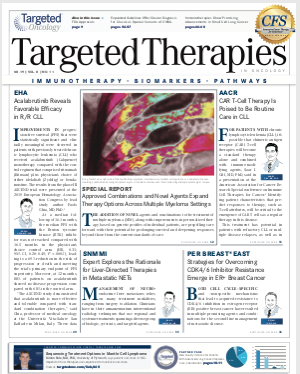CDK4/6 Inhibitor Combinations Could Have Lasting Benefits in ER+ Metastatic Breast Cancer
CDK4/6 inhibitors<strong> </strong>offer clear benefits in pro­gression-free survival, delayed time to chemotherapy, and overall survival in both pre and postmenopausal patients with estrogen receptor-positive metastatic breast cancer, said Angela DeMichele, MD, MSCE.
Angela DeMichele, MD, MSCE

Angela DeMichele, MD, MSCE
CDK4/6 inhibitorsoffer clear benefits in pro­gression-free survival (PFS), delayed time to chemotherapy, and overall survival (OS) in both pre and postmenopausal patients with estrogen receptor (ER)-positive metastatic breast cancer, said Angela DeMichele, MD, MSCE. However, she added, there are still unanswered questions about ideal sequencing and managing resistance and progression.1
“We still don’t know the ideal thing to do at the time of progression, but we do have some hints that there are things we could do, like take a break and try to go back and add a PI3 kinase [PI3K] inhibitor or even immunotherapy,” she said. “There are numerous mechanisms of resistance, and we need to figure out how we are going to deal with this because none of these agents work forever. All patients will progress on a CDK4/6 inhibitor.”
DeMichele is the Alan and Jill Miller Professor in Breast Cancer Excellence, coleader of the Breast Cancer Research Program, and director of the Breast Cancer Clinical Trials Unit at the University of Pennsylvania’s Abramson Cancer Center. She delivered a presentation on the changing field of care for ER-positive metastatic breast cancer at the18th AnnualInternational Congress on the Future of Breast Cancer® East hosted by Physicians’ Education Resource®, LLC.
Although endocrine therapy remains the standard of care, aromatase inhibitors and the downregulator fulvestrant (Faslodex) are typically administered alongside endocrine therapy, DeMichele said that patients inevitably develop resistance to treatment. The good news is that clinical results for the 3 FDA-approved CDK4/6 inhibitorsabemaciclib (Verzenio), palbociclib (Ibrance), and ribociclib (Kisqali)—have demonstrated efficacy in patients who have progressed following endocrine therapy.
Palbociclib was initially approved by the FDA in February 2015 for use in combination with letrozole as a frontline treatment for postmenopausal women with ER-positive, HER2-negative metastatic breast cancer.2In findings from the phase III PALOMA-3 trial, the median PFS was 11.2 months for palbociclib plus fulvestrant versus 4.6 months for fulvestrant alone (hazard ratio, 0.50; 95% CI, 0.40-0.62;P<.000001).3
In MONARCH 2, 669 women with hormone receptor-positive, HER2-negative advanced breast cancer resistant to endocrine therapy were assigned to abemaciclib plus fulvestrant or to placebo and fulvestrant. At a median follow-up of 19.5 months, the median PFS with the combination was 16.4 months compared with 9.3 months with placebo (hazard ratio, 0.553;P<.001). The objective response rates were 48.1% and 21.3%, respectively.4
Results from MONALEESA-3 similarly showed an improvement in PFS with the combination of ribociclib plus fulvestrant in this patient population. At the time of data cutoff in November 2017, the median PFS was 20.5 months with ribociclib/fulvestrant versus 12.8 months with placebo (hazard ratio, 0.593; 95% CI, 0.480-0.732;P= .00000041).5
The FDA expanded the ribociclib indication in July 2018 for use in combination with fulvestrant for the treatment of postmenopausal women with HR-positive, HER2-negative advanced or metastatic breast cancer, in the frontline setting or after disease progression on endocrine therapy based on data from the MONALEESA-3 trial.6
In comparison, adding a CDK4/6 inhibitor in first-line therapy resulted in a median PFS of 27.6 months (hazard ratio, 0.56; 95% CI, 0.46-0.69) as seen in PALOMA-2 and 25.3 months (hazard ratio, 0.57; 95% CI, 0.46-0.70) as seen in MONARCH 3 (TABLE).1The median PFS was not reached in MONALEESA-3.
“This illustrates that even though in the studies all the hazard ratios are around 0.5 [following progression], the absolute amount of time you get when you add the CDK4/6 inhibitor to endocrine therapy is the greatest if you add it in the first line,” she said. “But again, we don’t know this prospectively. I’m extrapolating from all of the studies we have so far.”

Overcoming Resistance
DeMichele said the main mechanisms of resistance are either related to endocrine resistance or CDK inhibitor resistance. Progression could be due to either agent or both. It will be necessary to use genomic tools to determine how to manage disease going forward based on the cause of resistance.
“There are numerous mechanisms of resistance, and we need to figure out how we are going to deal with this because none of these agents work forever,” she said. “All patients will progress on a CDK4/6 inhibitor.”
Findings from PALOMA-3 were the first to provide evidence that treatment with a CDK4/6 inhibitor could improve median OS. The combination of palbociclib/ fulvestrant improved OS by 6.9 months compared with placebo plus fulvestrant (34.9 vs 28.0 months).3
Moreover, investigators in PALOMA-3 analyzed paired blood samples for circulating tumor DNA (ctDNA) and found the driver mutationsPIK3CA,ESRl, YS37S, ERBB2, andFGFR2/3, as well as the palbociclib-specific mutation,RB-1after treatment. DeMichele said study results show there is some feasibility of detecting emergent genomic changes in blood with treatment and that mutations are concurrently affecting both endocrine and CDK inhibitor sensitivity. Furthermore, emerging mutations can provide hints on how to modify therapy but likely don’t tell the whole story.
The phase I/II TRINITI-1 trial was one of the first trials to target patients with HR-positive, HER2-negative advanced breast cancer who progressed following treatment with a CDK4/6 inhibitor and endocrine therapy. Patients were assigned to a triplet regimen of ribociclib, everolimus (Afinitor), and exemestane (Aromasin) in the single-arm trial. In data from 95 evaluable patients presented at the 2019 American Society of Clinical Oncology Annual Meeting, the triplet therapy demonstrated a median PFS of 5.7 months (95% CI, 3.6-9.1), with a 1-year PFS rate of 33.4% (95% CI, 22.8%-44.4%). At 24 weeks, the clinical benefit rate was 41.1% (95% CI, 31.1%-51.6%), 4 times greater than the minimum threshold for the study (>10%). The overall response rate was 8.4% (95% CI, 3.7%-15.9%), including 1 complete response and 7 partial responses.7
The most common gene alterations detected in ctDNA werePIK3CAandESR1. Among all patients with aPIK3CA(n = 30) and/orESR1mutation (n = 30), 14 had con- comitantPIK3CAandESR1mutations. The median PFS in patients withESR1wild-type disease was 6.9 months compared with 3.5 months for those with mutatedESR1. Similarly, those withPIK3CAwild-type tumors had superior median PFS compared with those who had a gene alteration (7.3 vs 5.7 months).
“If you look at these patients, all of whom progressed on endocrine therapy with a CDK4/6 inhibitor, and look at the efficacy of the therapy in those withESR1mutations, patients with the mutation were not doing as well with this combination as the wild-type patients,” DeMichele said. “It’s not clear at all that knowing the mutation status is going to be a home run in picking what we might do next.”
Pairing a CDK4/6 inhibitor with an immunotherapy agent may be a more promising avenue. CDK4/6 suppression increases T-cell activation and infiltration into lung tumors, increases chemokine trafficking, and boosts the efficiency of tumor cell antigen presentation.
“When you give a checkpoint inhibitor and a CDK4/6 inhibitor together, you get synergy,” DeMichele said. “This looks like a practical strategy.”
Investigators in the randomized, 3-arm phase II PACE trial are comparing fulvestrant monotherapy with or without palbociclib crossover at time of progression, fulvestrant plus palbociclib, and fulvestrant, palbociclib, and avelumab (Bavencio) in 220 patients with HR-positive, HER2-negative metastatic breast cancer (NCT03147287).
PACE is scheduled for primary completion in December 2020.
References
- DeMichele A. Evolving therapeutic strategies for ER+ metastatic breast cancer. Presented at:18th AnnualInternational Congress on the Future of Breast Cancer® East hosted by Physicians’ Education Resource®, LLC; July 19-20, 2019; New York, NY.
- First cyclin-dependent kinase 4/6 (CDK 4/6) inhibitor approved by the FDA: Ibrance now available for use in combination with letrozole as first-line treatment of postmeno- pausal women with estrogen receptor-positive, human epidermal growth factor receptor 2-negative (ER+/HER2-) metastatic breast Cancer [news release]. New York, NY: Pfizer Inc; February 3, 2015. bit.ly/2zxgshS. Accessed July 26, 2019.
- Turner NC, Slamon DJ, Ro I, et al. Overall survival with palbociclib and fulvestrant in advanced breast cancer.N Engl J Med. 2018;379(20):1926-1936. doi: 10.1056/ NEJMoa1810527.
- Sledge GW Jr, Toi M, Neven P, et al. MONARCH 2: abemaciclib in combination with fulvestrant in women with HR+/HER2-advanced breast cancer who had progressed while receiving endocrine therapy.J Clin Oncol. 2017;35(25):2875-2884. doi: 10.1200/ JCO.2017.73.7585.
- Slamon DJ, Neven P, Chia SKL, et al. Ribociclib (RIB) + fulvestrant (FUL) in postmeno- pausal women with hormone receptor-positive (HR+), HER2-negative (HER2) advanced breast cancer (ABC): results from MONALEESA-3.J Clin Oncol. 2018;36(suppl; abstr 1000). doi: 10.1200/JCO.2018.36.15_suppl.1000.
- FDA expands ribociclib indication in HR-positive, HER2-negative advanced or meta- static breast cancer. FDA website. bit.ly/2X6AUkG. Published July 18 , 2019. Accessed July 26, 2019.
- Bardia A, Hurvitz SA, DiMichele, et al. Triplet therapy (continuous ribociclib, everolim- us, exemestane) in HR+/HER2− advanced breast cancer postprogression on a CDK4/6 inhibitor (TRINITI-1): Efficacy, safety, and biomarker results.J Clin Oncol.2019;37(suppl 15; abstr 1016). doi: 10.1200/JCO.2019.37.15_suppl.1016.

Survivorship Care Promotes Evidence-Based Approaches for Quality of Life and Beyond
March 21st 2025Frank J. Penedo, PhD, explains the challenges of survivorship care for patients with cancer and how he implements programs to support patients’ emotional, physical, and practical needs.
Read More